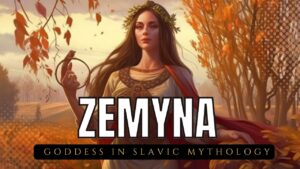Christ quickly spread across Europe, but it hadn’t made it to the Baltic Sea yet. People still did things this way that their ancestors did them. People met on holy mountains and in holy groves to thank the goddesses and gods who could help them with gifts. One of them was Emyna, the Earth Mother. Because she was the source of everything, her people often gave up things for her. Fans of hers would pour beer into the ground as an offering at the start of every event.
Zemyna was linked to both life and death because she was two different types of goddesses. Other gods kept living in the sky, but she lived on earth. She was known as the Mother of a Sands, the Mother of a Graves, and the Mother of a Poltergeist, among other names. In the Middle Ages, the Balts didn’t really see a difference between the living and the dead. This meant that Emyna was responsible for both the living and the dead. Giving birth was one thing she took care of in her life. People gave gifts to both Emyna and Laima, the queen of luck, when a baby was born, which usually took place in a holy baths. In fact, the women will share a holy meal these days. Everyone looked up to the goddess, but she was especially close to women. People often asked her for help because they thought she was one of the few gods who really cared about them.
But how did the Baltic women talk to their gods? Some important facts can be learned from a story about a Christian journey to Lithuania in the 1400s. The preacher John-Jerome of Prague worked hard at his job. He talked about his trip in an interview near the end of his life. Following his welcome by the duke, he went on a trip through Lithuania. While there, he met pagan people and tried to convert them to Christianity. The Lithuanians didn’t like him because he was very hostile. For instance, when he found out that every family had a sacred snake, he killed them all and set them on fire in the middle of the town. People he met kept a fire going all the time and told him about how Saule, the sun goddess, was locked up in a tower until the other gods came to save her.
John-Jerome tried hard to get these people to give up their old religion, but he wouldn’t let them go to holy places. Early medieval records of pagans in Europe talk about woods as places where they went to worship. But John-Account Jerome’s from the 1400s is one of the few that goes into as much depth. They went to church in a garden where all the plants were well taken care of. The most important tree, though, was an old one in the middle. It was possibly a big oak tree, which is the most common type of tree in the middle of Lithuanian sacred groves these days. Like people in other parts of Europe, Lithuanians believed in a world tree. It was usually an oak tree, and it was said that the sun princess Saule hung her belt on it before going to sleep under the ground at night. When John-Jerome told some people in the village to start cutting down other trees in the grove, they still wouldn’t touch this tree because they thought it was so holy. To cut down the tree, the preacher had to use an axe, which he did everywhere he went.






